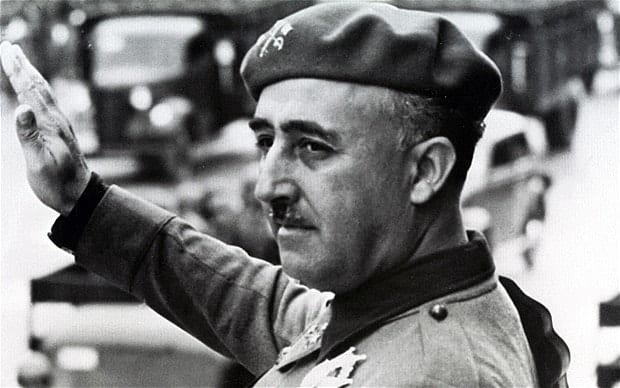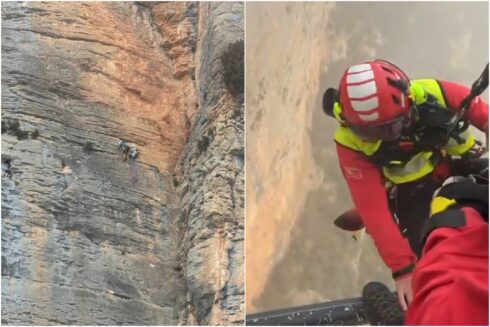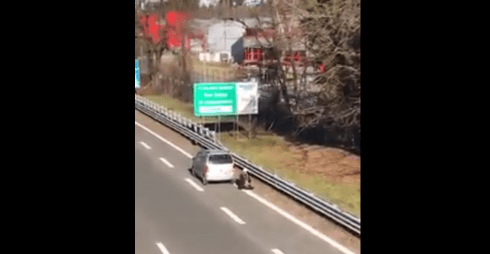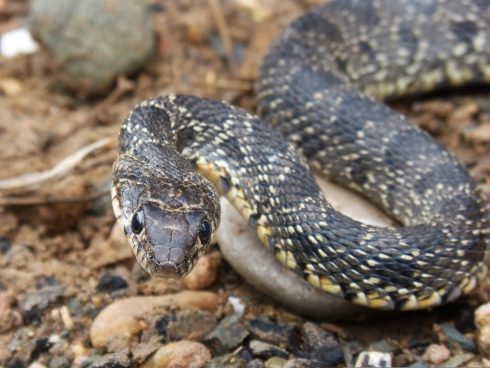
A QUEUE of traffic a kilometre long snakes up to the gates of the Valley of the Fallen.
As we inch forward, frying in the August heat, a large tattooed man draped in the Spanish flag steps out of the car in front and urinates on the road in direct view of my 18-year-old daughter.
Despite living in the shadow of Europe’s only remaining monument to a fascist leader – General Francisco Franco – I had not visited this striking but sinister place since 1993 when I was given short shrift for asking awkward questions.
I expected the reception to be different 25 years on and you could call it that.
The Valle de los Caidos, 50km from Madrid, is Franco’s OTT tribute to ‘the heroes and martyrs of the Crusade’ – a monolithic monument to those who ‘fell for God and for Spain in the Holy War against infidels, Masons, Marxists, homosexuals and feminists’.
With its 152-metre granite cross looming over the Sierra de Guadarrama like a fascist spook, the massive basilica and vaulted crypt bored 260 metres into the hillside by the sweat and blood of 22,000 political prisoners has always attracted ultra-right pilgrims as well as curious tourists. But today every pew in the cavernous black marble-floored church is packed more tightly than a box of communion wafers.

Spaniards of all ages are wedged in among the cast-iron candlesticks, crosses, torches and semi-fascist statues, including a wicked, sword-wielding angel.
Ostensibly they are here for the traditional 11am Sunday Mass, lead by Benedictine monks who have been entrusted with the basilica since 1958.
But there’s no doubt that most who have flocked to the beautiful Cuelgamuros Valley on this glorious summer morning are here to defend El Caudillo’s right to remain in his state-funded mausoleum.
The service over, the congregation hastens to take selfies beside the dictator’s tomb. If all goes to government decree, it will soon be an insignificant slab of black marble, ditto the adjacent tomb of Falangist party founder Jose Antonio Primo de Rivera.
But Carlos Rubio, an engineer who has driven 150 km from Valladolid, is angry. “It’s a crime of prevarication and the desecration of a tomb”, he tells me.

“It is an attack on our liberty and we are here today to defend it,” he continues, as his 17-year-old son nods in agreement.
“Politically, it is an intolerable intervention from the state into the private sphere. It is well known that socialism deprives citizens of liberty, just look at the USSR and Venezuela. What we have in Spain is increasingly akin to those examples and this is just another step in that direction.”
Spain is a country still divided between those nostalgic for the Franco days and those who abhorred El Generalisimo. Not long after he died in 1975, an American actress from Little House on the Prairie famously danced on his tomb.
But for those who might like to follow suit, the window of opportunity is closing fast. The decree, still to be voted on by Congress, gives Franco’s family only a brief period to claim his body and find an alternative resting place.
The Martínez-Bordiú Franco clan are contesting it as ‘an act of retrospective revenge without precedent in the civilized world’.
But it is not just Franco’s relatives and supporters who wonder at the exhumation, 43 years after the dictator’s demise.

Hispanist Sir Paul Preston, author of one of the most widely-read Franco biographies, told the Olive Press: “For people on the left, it is perceived as scandalous that there should be a monument to the dictator. Imagine if there was one to Hitler in Germany. The big question is why now?
“It’s a lot to do with the fact that the PSOE government has very little power. Given that it has been losing support in recent years, this is a gesture that might go some way to helping rebuild Socialist support.”
Fellow Hispanist Ian Gibson, author of best-selling biographies on the poet Lorca and the artist Salvador Dalí, believes the issue should have been resolved back in the 1980s after the attempted coup and the drawing up of the Spanish Constitution. But the consensus was that the only way forward was to ignore the past.
“After Tejero [Lieutenant Colonel Antonio Tejero who led the coup] the PSOE, with its astronomical majority, could have at least initiated the process but it didn’t,” says the Irishman.
“They were in power for fourteen years. I think it was cowardly. They deny it, saying it wasn’t possible; that it was dangerous (with the Army). But you have to face up to the bullies when you have the opportunity and they didn’t.”

But Boni Sánchez of the Historical Memory Association contests: “It is happening now because we never broke with Francoism in Spain.
“The transition and democracy were built on a foundation of silence and a pact of forgetting. We’ve arrived at this point because previous governments, both from the Popular Party and the Socialists, were committed to forgetting and silence, mainly because many politicians had their roots in Francoism.”
Every year on November 20 until it was banned in 2007, the ultra-right from Spain and beyond would congregate on the basilica’s theatrical grand esplanade to mark Franco’s death with stiff-armed fascist salutes and a hearty rendition of the Falangist anthem Cara al Sol.

Since the exhumation was placed firmly on Pedro Sánchez’s agenda in July, the numbers visiting his shrine have rocketed by 50%.
But according to 92-year-old historian Nicolás Sánchez-Albornoz, removing Franco will change nothing.
One of the 22,000 prisoners forcibly put to work on the project among the pine forests of Cuelgamuros in 1948 until his lucky escape four months later, he says: “It will remain symbolic of the regime. I refuse to call it the Valley of the Fallen. It is not a monument to the ‘fallen’ but a monument to Franco’s victory in the war.”
Nevertheless, he believes: “The sooner it is gone, the better. The Francoists have hung on to the site for too long. Despite their professed allegiance to democracy, they have never condemned the dictatorship. There is no coherence in that.”

Franco chose the site for his mausoleum with care, below one of the Civil War’s first battle fields at Guadarrama Pass in a natural amphitheatre where it would be silhouetted against an infinite number of sunsets.
More significantly, it was close to the monastery built by Philip II in San Lorenzo del Escorial, 12 km away. Franco wanted nothing more than to be associated with the Catholic Kings and the glorious imperialism of the past.
A year after his National army defeated the Republicans, the dictator led a cavalcade of official vehicles to Cuelgamuros to watch the first blast of dynamite marking his so-called ‘national act of atonement’.
But such was the monument’s monolithic scale, the one-year project ran to 18 and Franco’s so-called ‘national act of atonement’ became a source of continuing division and resentment within Spain.
“We are talking about thousands of Republicans who lie in a mass grave,” insists Boni Sanchez. “We’re talking about thousands of Spaniards who worked like slaves to build this vast monument to the dictator. We’re also talking about the role the Spanish Catholic Church played in the dictatorship, along with the army. That angers Francoists but it’s the truth.
“And, finally, we are speaking about the untold numbers who subsequently died of silicosis, the miner’s disease, from breathing in the granite dust without protection.”
A national holiday was declared to mark the monument’s 1959 inauguration, held on the 20th anniversary of the Civil War’s end, and buses were laid on to ferry workers from the capital for the ceremony. Franco, wearing full military regalia, and his wife Carmen decked out in mantilla and high comb, walked the length of the basilica to take their seats on two thrones, watched by the entire cabinet and officials from across the country.
Franco was all but King of Spain and the Valley of the Fallen was his castle. Such was his obsession, it was referred to as his ‘other woman’.

With the recent decree, Pedro Sanchéz aims to transform the site ‘so it ceases to be a place of Francoist and national-Catholic memory.’ As he put it in Parliament, it will become ‘a space where the culture of reconciliation and collective democratic memory can flourish, where the victims of the Civil War and the dictatorship are recognised and treated with dignity’.
Some, like 21-year-old Victor Sánchez who was among that Sunday’s congregation, believe Franco should be left to rest in peace; that wounds will be reopened. Ian Gibson disagrees. “The wounds were never healed. The Spanish nation has got to face up to the horror of the Franco genocide and exhume all its dead.”
For Ghosts of Spain author Giles Tremlett, the biggest question is what happens next. “I would really like to see the whole thing converted into a proper museum that explains the Civil War and what happened afterwards so people can understand it and come to their own well-informed conclusions,” he told the Olive Press.
Gibson, however, believes the site to be “so horrible and forbidding and evil that that, too, would not be a solution. Maybe it could be cordoned off, blown up or simply left to cave in.”
And what of Franco’s remains, should the family lose its legal battle to keep them within the basilica? Would a fresh burial site simply become an alternative place of pilgrimage?
“My solution would be for him to be buried at sea,” offers Paul Preston. “He always wanted to join the navy. When he became dictator, he dressed as an admiral at every possible opportunity. I doubt if it would happen but, if it were suggested, I think that the family would be hard put to object.”









An excellent piece. Spain’s shame that so many thousands of people died in horrible conditions building this blot on the landscape. It’s chilling.